2014 NISSAN ROGUE oil pressure
[x] Cancel search: oil pressurePage 349 of 442
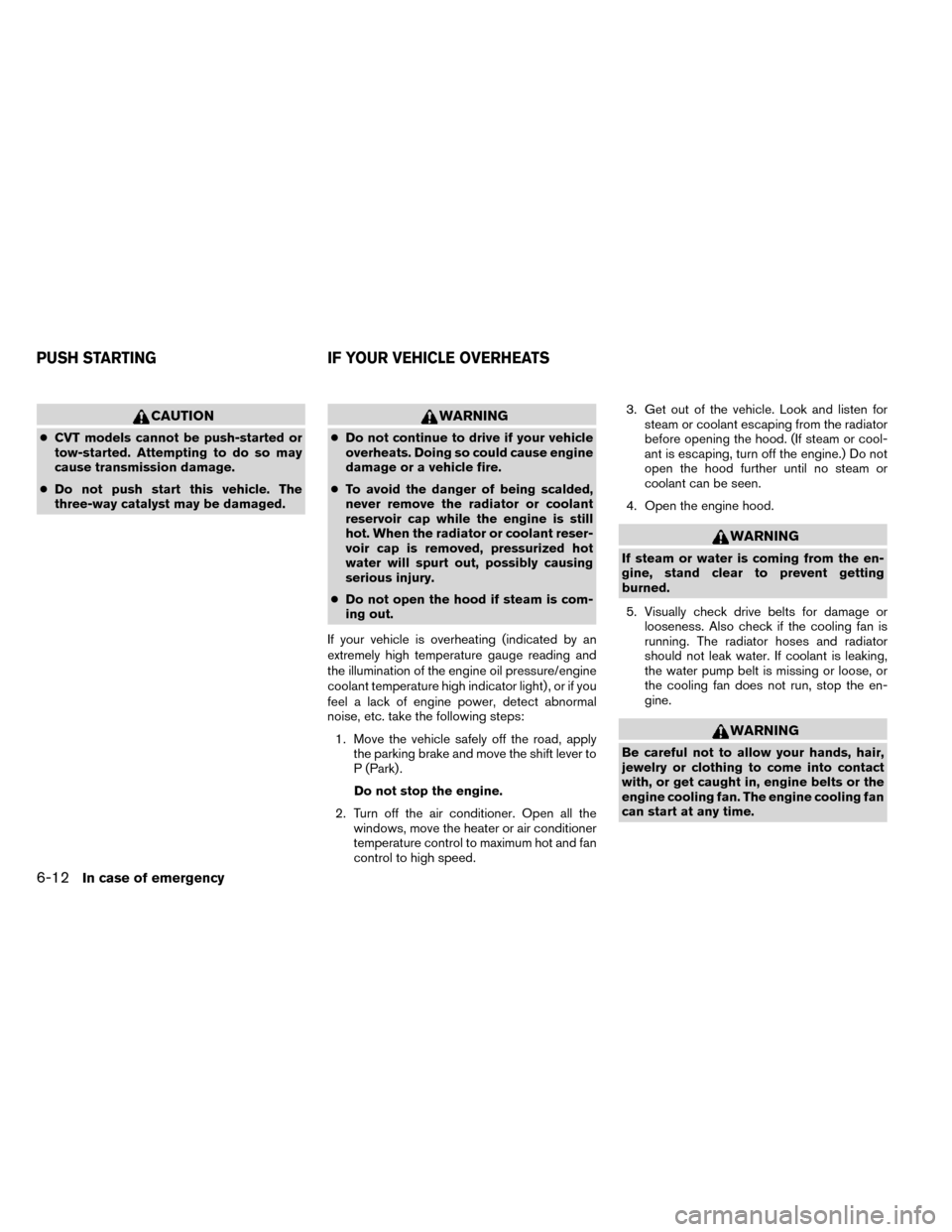
CAUTION
●CVT models cannot be push-started or
tow-started. Attempting to do so may
cause transmission damage.
● Do not push start this vehicle. The
three-way catalyst may be damaged.
WARNING
● Do not continue to drive if your vehicle
overheats. Doing so could cause engine
damage or a vehicle fire.
● To avoid the danger of being scalded,
never remove the radiator or coolant
reservoir cap while the engine is still
hot. When the radiator or coolant reser-
voir cap is removed, pressurized hot
water will spurt out, possibly causing
serious injury.
● Do not open the hood if steam is com-
ing out.
If your vehicle is overheating (indicated by an
extremely high temperature gauge reading and
the illumination of the engine oil pressure/engine
coolant temperature high indicator light) , or if you
feel a lack of engine power, detect abnormal
noise, etc. take the following steps: 1. Move the vehicle safely off the road, apply the parking brake and move the shift lever to
P (Park) .
Do not stop the engine.
2. Turn off the air conditioner. Open all the windows, move the heater or air conditioner
temperature control to maximum hot and fan
control to high speed. 3. Get out of the vehicle. Look and listen for
steam or coolant escaping from the radiator
before opening the hood. (If steam or cool-
ant is escaping, turn off the engine.) Do not
open the hood further until no steam or
coolant can be seen.
4. Open the engine hood.
WARNING
If steam or water is coming from the en-
gine, stand clear to prevent getting
burned.
5. Visually check drive belts for damage or looseness. Also check if the cooling fan is
running. The radiator hoses and radiator
should not leak water. If coolant is leaking,
the water pump belt is missing or loose, or
the cooling fan does not run, stop the en-
gine.
WARNING
Be careful not to allow your hands, hair,
jewelry or clothing to come into contact
with, or get caught in, engine belts or the
engine cooling fan. The engine cooling fan
can start at any time.
PUSH STARTING IF YOUR VEHICLE OVERHEATS
6-12In case of emergency
Page 360 of 442
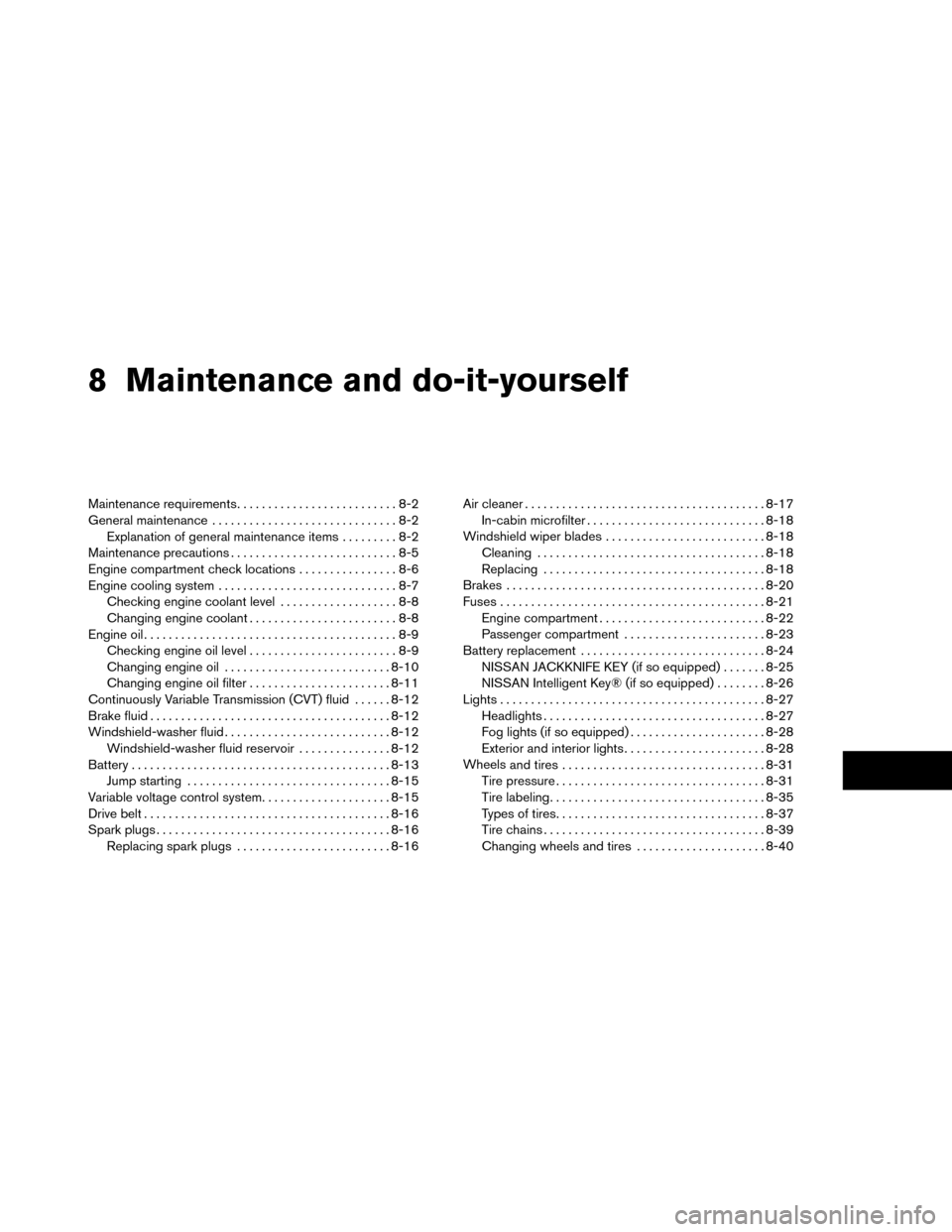
8 Maintenance and do-it-yourself
Maintenance requirements..........................8-2
General maintenance ..............................8-2
Explanation of general maintenance items .........8-2
Maintenance precautions ...........................8-5
Engine compartment check locations ................8-6
Engine cooling system .............................8-7
Checking engine coolant level ...................8-8
Changing engine coolant ........................8-8
Engine oil .........................................8-9
Checking engine oil level ........................8-9
Changing engine oil ........................... 8-10
Changing engine oil filter .......................8-11
Continuously Variable Transmission (CVT) fluid ......8-12
Brake fluid ....................................... 8-12
Windshield-washer fluid ........................... 8-12
Windshield-washer fluid reservoir ...............8-12
Battery .......................................... 8-13
Jump starting ................................. 8-15
Variable voltage control system .....................8-15
Drive belt ........................................ 8-16
Spark plugs ...................................... 8-16
Replacing spark plugs ......................... 8-16Air cleaner
....................................... 8-17
In-cabin microfilter ............................. 8-18
Windshield wiper blades .......................... 8-18
Cleaning ..................................... 8-18
Replacing .................................... 8-18
Brakes .......................................... 8-20
Fuses ........................................... 8-21
Engine compartment ........................... 8-22
Passenger compartment .......................8-23
Battery replacement .............................. 8-24
NISSAN JACKKNIFE KEY (if so equipped) .......8-25
NISSAN Intelligent Key® (if so equipped) ........8-26
Lights ........................................... 8-27
Headlights .................................... 8-27
Fog lights (if so equipped) ......................8-28
Exterior and interior lights .......................8-28
Wheels
and tires ................................. 8-31
Tire pressure . . . ............................... 8-31
Tire labeling ................................... 8-35
Types of tires .................................. 8-37
Tire chains .................................... 8-39
Changing wheels and tires .....................8-40
Page 364 of 442
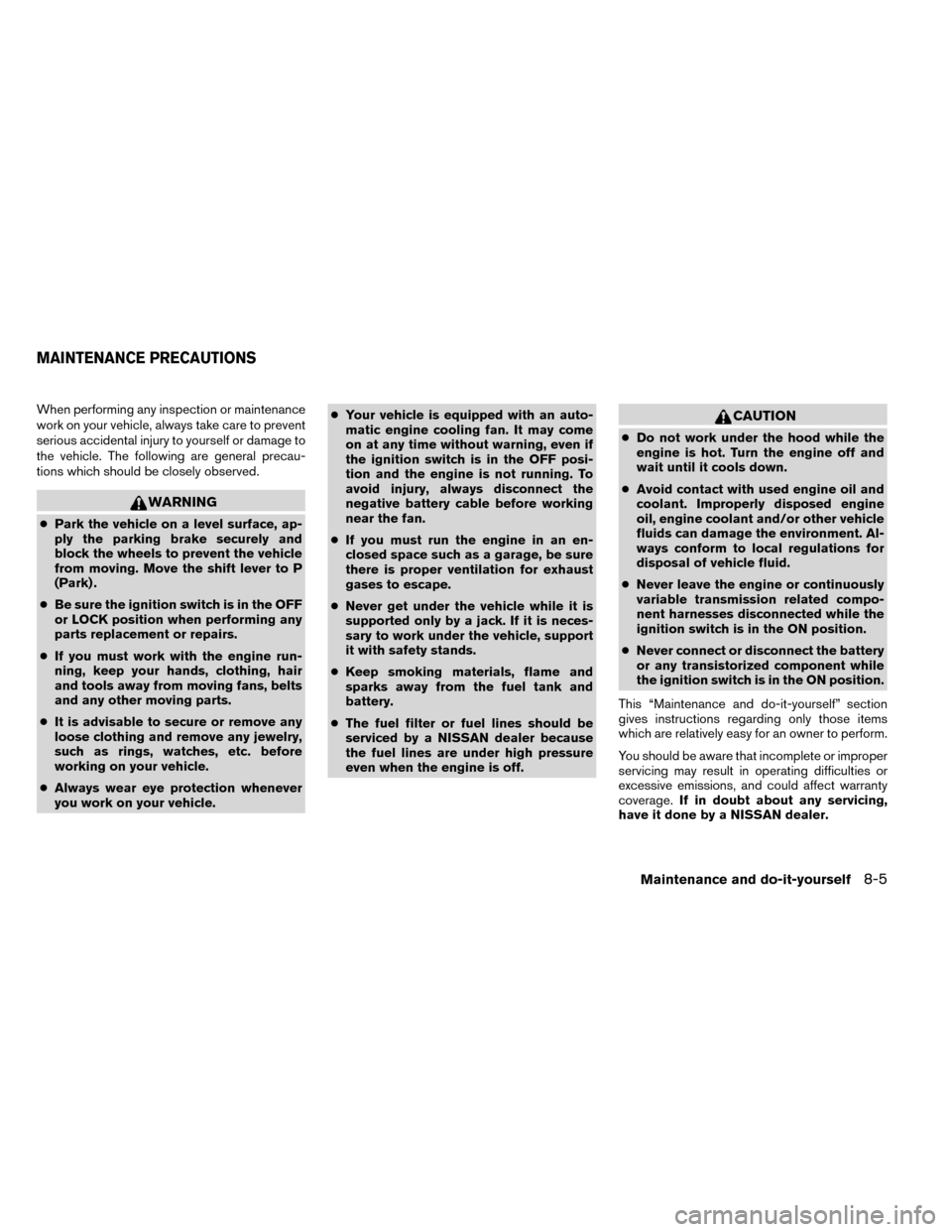
When performing any inspection or maintenance
work on your vehicle, always take care to prevent
serious accidental injury to yourself or damage to
the vehicle. The following are general precau-
tions which should be closely observed.
WARNING
●Park the vehicle on a level surface, ap-
ply the parking brake securely and
block the wheels to prevent the vehicle
from moving. Move the shift lever to P
(Park) .
● Be sure the ignition switch is in the OFF
or LOCK position when performing any
parts replacement or repairs.
● If you must work with the engine run-
ning, keep your hands, clothing, hair
and tools away from moving fans, belts
and any other moving parts.
● It is advisable to secure or remove any
loose clothing and remove any jewelry,
such as rings, watches, etc. before
working on your vehicle.
● Always wear eye protection whenever
you work on your vehicle. ●
Your vehicle is equipped with an auto-
matic engine cooling fan. It may come
on at any time without warning, even if
the ignition switch is in the OFF posi-
tion and the engine is not running. To
avoid injury, always disconnect the
negative battery cable before working
near the fan.
● If you must run the engine in an en-
closed space such as a garage, be sure
there is proper ventilation for exhaust
gases to escape.
● Never get under the vehicle while it is
supported only by a jack. If it is neces-
sary to work under the vehicle, support
it with safety stands.
● Keep smoking materials, flame and
sparks away from the fuel tank and
battery.
● The fuel filter or fuel lines should be
serviced by a NISSAN dealer because
the fuel lines are under high pressure
even when the engine is off.
CAUTION
● Do not work under the hood while the
engine is hot. Turn the engine off and
wait until it cools down.
● Avoid contact with used engine oil and
coolant. Improperly disposed engine
oil, engine coolant and/or other vehicle
fluids can damage the environment. Al-
ways conform to local regulations for
disposal of vehicle fluid.
● Never leave the engine or continuously
variable transmission related compo-
nent harnesses disconnected while the
ignition switch is in the ON position.
● Never connect or disconnect the battery
or any transistorized component while
the ignition switch is in the ON position.
This “Maintenance and do-it-yourself” section
gives instructions regarding only those items
which are relatively easy for an owner to perform.
You should be aware that incomplete or improper
servicing may result in operating difficulties or
excessive emissions, and could affect warranty
coverage. If in doubt about any servicing,
have it done by a NISSAN dealer.
MAINTENANCE PRECAUTIONS
Maintenance and do-it-yourself8-5
Page 434 of 442
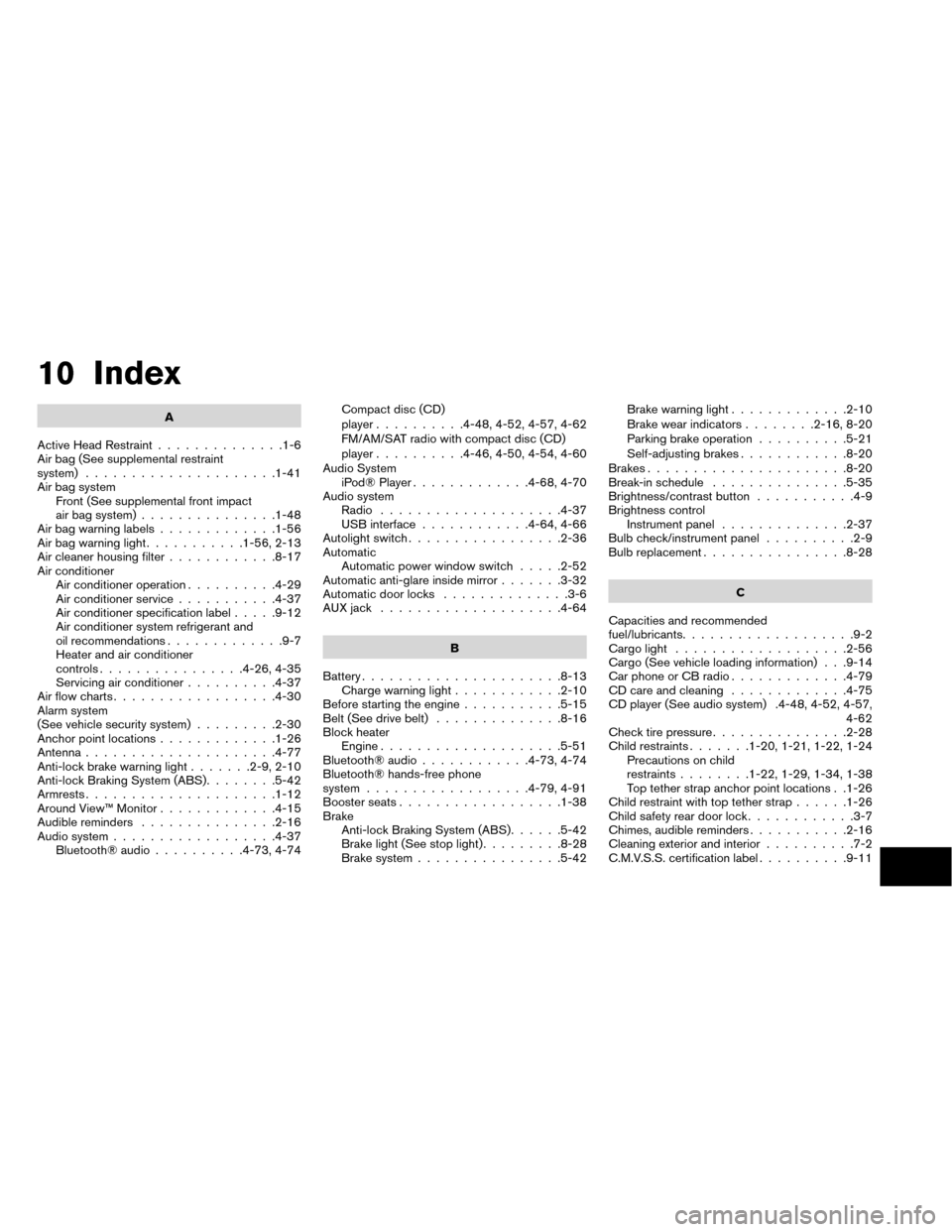
10 Index
A
Active Head Restraint ..............1-6
Air bag (See supplemental restraint
system) .....................1-41
Air bag system Front (See supplemental front impact
air bag system) ...............1-48
Air bag warning labels .............1-56
Airbagwarninglight...........1-56,2-13
Air cleaner housing filter ............8-17
Air conditioner Air conditioner operation ..........4-29
Air conditioner service ...........4-37
Air conditioner specification label .....9-12
Air conditioner system refrigerant and
oil recommendations .............9-7
Heater and air conditioner
controls................4-26,4-35
Servicing air conditioner ..........4-37
Airflowcharts..................4-30
Alarm system
(See vehicle security system) .........2-30
Anchor point locations .............1-26
Antenna .....................4-77
Anti-lock brake warning light .......2-9,2-10
Anti-lock Braking System (ABS) ........5-42
Armrests.....................1-12
Around View™ Monitor .............4-15
Audible reminders ...............2-16
Audio system ..................4-37
Bluetooth® audio ..........4-73,4-74 Compact disc (CD)
player
..........4-48,4-52,4-57,4-62
FM/AM/SAT radio with compact disc (CD)
player ..........4-46,4-50,4-54,4-60
Audio System iPod® Player .............4-68,4-70
Audio system Radio ....................4-37
USBinterface............4-64,4-66
Autolightswitch.................2-36
Automatic Automatic power window switch .....2-52
Automatic anti-glare inside mirror .......3-32
Automatic door locks ..............3-6
AUXjack ....................4-64
B
Battery......................8-13 Charge warning light ............2-10
Before starting the engine ...........5-15
Belt(Seedrivebelt) ..............8-16
Block heater Engine ....................5-51
Bluetooth® audio ............4-73,4-74
Bluetooth® hands-free phone
system ..................4-79,4-91
Booster seats ..................1-38
Brake Anti-lock Braking System (ABS) ......5-42
Brakelight(Seestoplight).........8-28
Brake system ................ 5-42Brakewarninglight.............2-10
Brake wear indicators
........2-16,8-20
Parking brake operation ..........5-21
Self-adjusting brakes ............8-20
Brakes ......................8-20
Break-in schedule ...............5-35
Brightness/contrast button ...........4-9
Brightness control Instrument panel ..............2-37
Bulb check/instrument panel ..........2-9
Bulb replacement ................8-28
C
Capacities
and recommended
fuel/lubricants ...................9-2
Cargolight ...................2-56
Cargo (See vehicle loading information) . . .9-14
Car phone or CB radio .............4-79
CD care and cleaning .............4-75
CD player (See audio system) .4-48, 4-52, 4-57, 4-62
Check tire pressure ...............2-28
Childrestraints.......1-20,1-21,1-22,1-24 Precautions on child
restraints........1-22,1-29,1-34,1-38
Top tether strap anchor point locations . .1-26
Childrestraintwithtoptetherstrap......1-26
Child safety rear door lock ............3-7
Chimes, audible reminders ...........2-16
Cleaning exterior and interior ..........7-2
C.M.V.S.S. certification label ..........9-11
Page 437 of 442
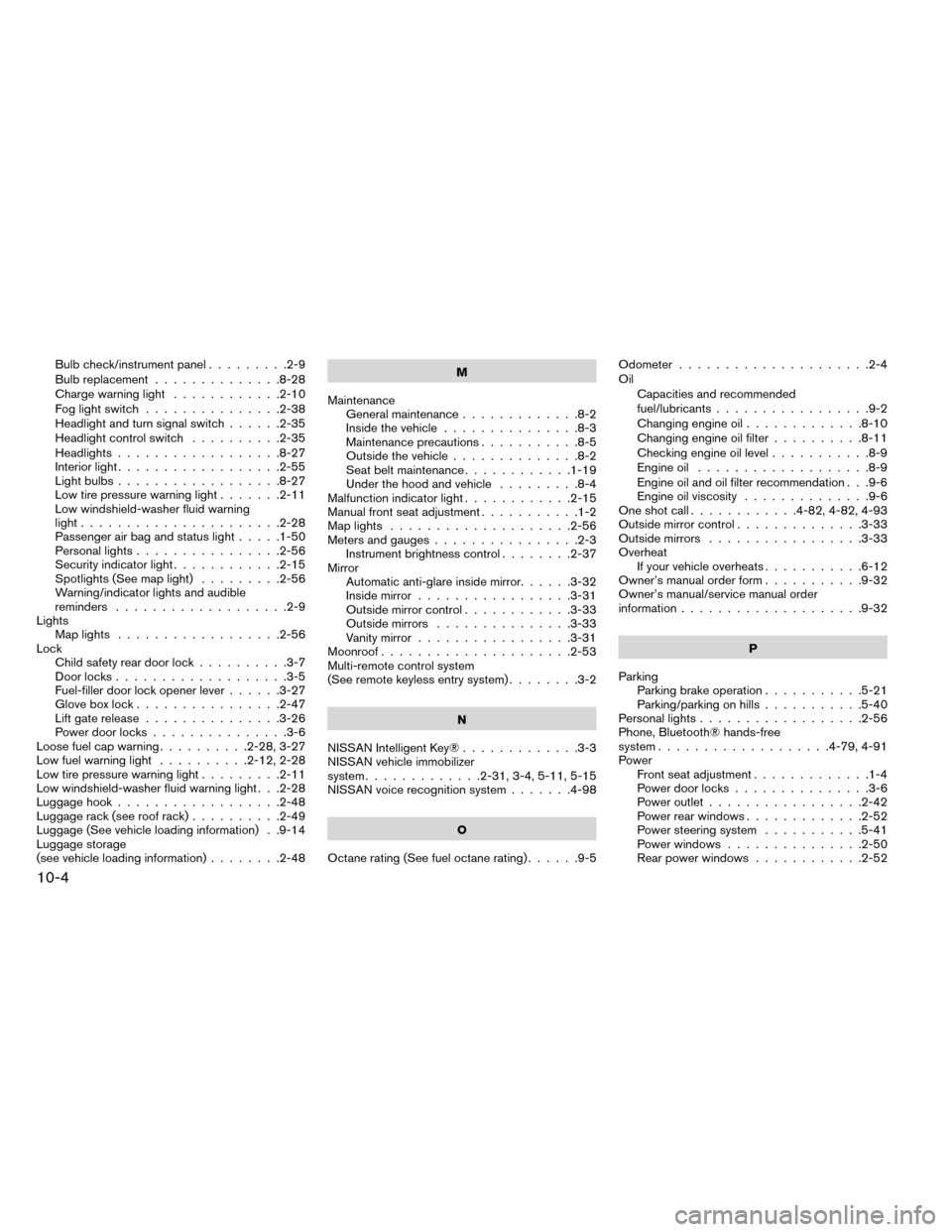
Bulb check/instrument panel.........2-9
Bulb replacement ..............8-28
Charge warning light ............2-10
Foglightswitch ...............2-38
Headlight and turn signal switch ......2-35
Headlight control switch ..........2-35
Headlights ..................8-27
Interiorlight..................2-55
Lightbulbs..................8-27
Low tire pressure warning light .......2-11
Low windshield-washer fluid warning
light......................2-28
Passenger air bag and status light .....1-50
Personal lights ................2-56
Security indicator light ............2-15
Spotlights(Seemaplight) .........2-56
Warning/indicator lights and audible
reminders ...................2-9
Lights Maplights ..................2-56
Lock Child safety rear door lock ..........3-7
Door locks ...................3-5
Fuel-filler door lock opener lever ......3-27
Gloveboxlock................2-47
Lift gate release ...............3-26
Power door locks ...............3-6
Loose fuel cap warning ..........2-28,3-27
Lowfuelwarninglight ..........2-12,2-28
Low tire pressure warning light .........2-11
Low windshield-washer fluid warning light . . .2-28
Luggage hook ..................2-48
Luggage rack (see roof rack) ..........2-49
Luggage (See vehicle loading information) . .9-14
Luggage storage
(see vehicle loading information) ........2-48 M
Maintenance General maintenance .............8-2
Inside the vehicle ...............8-3
Maintenance precautions ...........8-5
Outside the vehicle ..............8-2
Seat belt maintenance ............1-19
Under the hood and vehicle .........8-4
Malfunctionindicatorlight............2-15
Manual front seat adjustment ...........1-2
Maplights ....................2-56
Meters and gauges ................2-3
Instrument brightness control ........2-37
Mirror Automatic anti-glare inside mirror ......3-32
Inside mirror .................3-31
Outside mirror control ............3-33
Outside mirrors ...............3-33
Vanity mirror .................3-31
Moonroof .....................2-53
Multi-remote control system
(See remote keyless entry system) ........3-2
N
NISSAN Intelligent Key® .............3-3
NISSAN vehicle immobilizer
system .............2-31,3-4,5-11,5-15
NISSAN voice recognition system .......4-98
O
Octanerating(Seefueloctanerating)......9-5 Odometer
.....................2-4
Oil Capacities and recommended
fuel/lubricants .................9-2
Changing engine oil .............8-10
Changing engine oil filter ..........8-11
Checking engine oil level ...........8-9
Engine oil ...................8-9
Engine
oil and oil filter recommendation . . .9-6
Engine oil viscosity ..............9-6
One shot call ............4-82,4-82,4-93
Outside mirror control ..............3-33
Outside mirrors .................3-33
Overheat If your vehicle overheats ...........6-12
Owner’s manual order form ...........9-32
Owner’s manual/service manual order
information....................9-32
P
Parking Parking brake operation ...........5-21
Parking/parking on hills ...........5-40
Personal lights ..................2-56
Phone, Bluetooth® hands-free
system ...................4-79,4-91
Power Front seat adjustment .............1-4
Power door locks ...............3-6
Power outlet .................2-42
Power rear windows .............2-52
Power steering system ...........5-41
Power windows ...............2-50
Rear power windows ............2-52
10-4
Page 441 of 442

FUEL RECOMMENDATION
Use unleaded regular gasoline with an octane
rating of at least 87 AKI (Anti-Knock Index) num-
ber (Research octane number 91) .
CAUTION
●Only vehicles with the E-85 filler door
label can operate on E-85. Fuel system
or other damage can occur if E-85 is
used in vehicles that are not designed
to run on E-85.
● Using a fuel other than that specified
could adversely affect the emission
control system, and may also affect the
warranty coverage.
● Under no circumstances should a
leaded gasoline be used, because this
will damage the three-way catalyst.
● Do not use E-15 or E-85 fuel in your
vehicle. Your vehicle is not designed to
run on E-15 or E-85 fuel. Using E-15 or
E-85 fuel in a vehicle not specifically
designed for E-15 or E-85 fuel can ad-
versely affect the emission control de-
vices and systems of the vehicle. Dam-
age caused by such fuel is not covered
by the NISSAN new vehicle limited
warranty. ●
U.S. government regulations require
ethanol dispensing pumps to be identi-
fied by a small, square, orange and
black label with the common abbrevia-
tion or the appropriate percentage for
that region.RECOMMENDED ENGINE OIL:
•Genuine NISSAN engine oil or equivalent
•Engine oil with API Certification Mark
•Viscosity SAE 0W-20
See “Engine oil and oil filter recommendations” in
the “Technical and consumer information” sec-
tion of this manual.
COLD TIRE PRESSURE:
See Tire and Loading Information label.
The label is typically located on the driver side
center pillar or on the driver’s door. For additional
information, refer to “Wheels and tires” in the
“Maintenance and do-it-yourself” section of this
manual.
RECOMMENDED NEW VEHICLE
BREAK-IN PROCEDURE:
During the first 1,200 mi (2,000 km) of vehicle
use, follow the recommendations outlined in the
“Break-in schedule” information found in the
“Starting and driving” section of this manual. Fol-
low these recommendations for the future reli-
ability and economy of your new vehicle. Failure
to follow these recommendations may result in
vehicle damage or shortened engine life.
GAS STATION INFORMATION